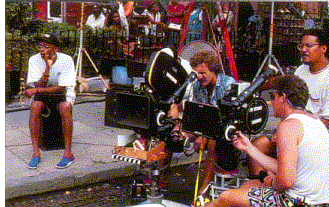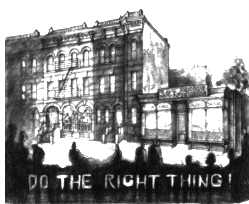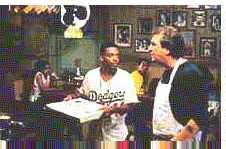PRODUCTIONS DESIGNERS // "Quiet On The Streets!" |
"Quiet On The Streets!"A 1989 article about filming on the streets of New York City, featuring interviews with production designer Wynn Thomas on DO THE RIGHT THING, and location managers David de Clerque and Nick Bernstein on A SHOCK TO THE SYSTEM and CADILLAC MAN |  |
|
On an Autumn Sunday afternoon, Bleecker Street between Seventh Avenue and Grove was littered with debris, most curiously by a plethora of stuffed toys strewn on the sidewalk and dangling on a storefront's awning. What was unusual was that the debris was placed there very deliberately, belying the impression that something had exploded. A sequence from the movie SEE NO EVIL, HEAR NO EVIL was being filmed, in which doubles for Gene Wilder and Richard Pryor were to drive a commandeered police car over the sidewalk, through an outdoor cafe and around the corner. Dozens of curious locals line the street opposite the action, crowding the entrance to a D'Agostino's and eliciting angry euphemisms from detained shoppers. The film's assistant directors try to direct traffic away from the camera's view, and occasionally halt cars at the nearby intersection so that the cameras may roll. Not all the drivers are enamored with witnessing the process of movie-making. Extras could be seen running up to a squad car at the far corner, miming agitated responses to the scene's central action, as the stunt car sideswipes the restaurant's patrons on yet another take. Most of the past hour has been spent in setting up the props and lining up cars and actors, so what the collected audience sees — for the most part — is not much more exciting than the passing of cables and the switching on and off of lights. Film production is rarely the glamorous enterprise it is often painted to be; still, encountering a movie being shot on the streets of New York does contain a certain amount of entertainment, if only in knowing that one's own turf is being photographed as backdrop for a high-speed car chase or moonlit romance. Yet in a metropolitan area as vast as New York, finding and selecting locations for film, TV and commercial shoots is a Herculean task, with hurdles of logistics, bureaucracy and economics to be surmounted. David de Clerque, a location manager whose past experiences include blowing up cars on the elevated West Side Highway for SHAKEDOWN, likens the stamina and diplomacy needed to secure permission to set up film shoots at the desired locations to that needed by a door-to-door salesman: "You have to knock on a lot of doors and never be afraid to ask. We try to keep up good relationships; we're dependent upon a lot of different people, and if you're asking to tear up someone's lawn or knock out a picture window, they have to trust you that you'll return things exactly as they were. "Some people get very excited, they think it's a lot of fun; others don't want to be bothered. Some think it's like winning the lottery, because they've heard stories about other people being paid thousands to let a film crew use their home. Now there are Fifth Avenue homes worth $10 million, so what's their owners' incentive to let you rent their homes for a movie? Some just get a kick out of it."
In searching for the perfect setting for the movie CADILLAC MAN, in which a hostage situation occurs at a car dealership, location manager Nick Bernstein conducted a survey of over 500 auto showrooms in the New York Metropolitan area: "We could have been just as happy to do the film in Philadelphia, for instance, but Roger [Donaldson, the director] wanted the feel of New York. And we all wanted to shoot in New York. "We had very specific needs: we needed a dealership that was old, not in a great neighborhood — it had to be commercial and somewhat run-down — yet it had to look very New York. One location we saw would have been great, but right across the street it looked like Kansas or Cementville. And of course whatever site we ended up choosing would have to be feasible for us to shoot at for two months." Once a site was decided upon — a Buick showroom on Northern Boulevard in Queens — steps had to be taken to equip it for two months of filming. "We had a massive pre-production period of 8 weeks, in which we had to dress the showroom, put in carpeting and light it. Because it was overlooking Northern Boulevard, and we couldn't close down traffic on that street for 8 hours every day — it's the main artery for the 59th Street Bridge — we knocked down a 30-foot wall and installed a 30-foot window overlooking a side street we could shut down. And we double-glazed the windows to cut down on noise." Yet shooting on a commercial street not surprisingly pitted the producers against local merchants who found it increasingly difficult to conduct business. "You had to be incredible in diplomacy," Bernstein recalls. "Every few days tensions would flare up. Someone making a delivery of 100 rugs at 8 o'clock, and you go and tell him Your trucks can't be there, we're shooting!" You try to explain to them that you're shooting a scene over a three-hour period and it all has to match. And people think you have unlimited amounts of money, and they want to know, Well. why can't you give us $2000 more?' And being a big movie with a big star like Robin Williams doesn't help; for one week, having us there was a novelty for them, but then it was just a pain." Bernstein thankfully recalled there being no major nightmares with neighboring businesses, but the production was a logistical nightmare, with lots of minor things to worry about, such as installing Port-O-Sans for the 500 extras that were called upon to appear for up to two weeks. One unusual concession the filmmakers made to local residents was to the home for the blind located across the street: "We were across from The Lighthouse, and the traffic signals there beep eight times whenever the light turns green so that blind people will know when it's safe to cross the street. We couldn't have that going off all day so we had to shut off the beeper and hire crossing guards."
Wynn Thomas, a production designer who has worked on all of Spike Lee's features, originally had misgivings about the settings for his most recent film, DO THE RIGHT THING, and in fact found the locations called for in the story rather lacking in variety. "When I first saw the script, I thought, 'Hmm...a pizzeria and a block, he said. To convey the story's strong sense of place and atmosphere, in which the hottest day of the year serves as the setting for growing racial tensions in a Brooklyn neighborhood, Thomas had to help choose and then refit a city block to serve as the film crew's locale for an eight-week shoot. "Spike and I had decided that the block definitely should be in Bedford-Stuyvesant," he explained. "The buildings in Bed-Stuy have a lot of character — brownstones with wonderful architectural details — and as a designer those were the things that interested me. But it wasn't so much that I went there and was inspired by the architecture; I came in and took advantage of the space to make it work for the script. I went there to fix up, to rehab the block for the picture. It is better to work with a block that's not in good shape and bring it up as opposed to taking a block that's in very good shape and dressing it down.
"Fortunately we found Stuyvesant Avenue between Lexington and Quincy, after searching for little over a week. It did have the two vacant lots — actually one of the lots was a community garden which we destroyed; the other lot had a shack on it in which a guy was storing equipment. Also, half the buildings on Stuyvesant Avenue were abandoned; a quarter were city-owned, and the remaining quarter were owner-occupied. By finding a block that had a lot of abandoned buildings, I was able to come in and do what I needed to do to make the block fit the picture. "I think you'd be shocked at how much work went into it to make it look like a normal block. Half the block looked like it had been devastated, like it was Dresden or something, and on the other half people lived and they took care of their homes. Now when you see the film, the whole block looks very lived-in." Before his production company put down stakes on Stuyvesant Avenue, Lee hired his own security forces, enlisting members of the Fruit of Islam, whose presence helped empty out two crackhouses (which later served as Jade's apartment and as the WE-LOVE radio station). But in addition to making a destitute area appear to be a thriving neighborhood on screen, Thomas was responsible for making sure it did not appear "fake," or untrue to the demands of the narrative: the block had to be a place which provided little or no relief from the tensions and frustrations that mounted during the course of the picture. "The street only had one tree, which became very important," said Thomas, "because I as a designer didn't want there to be a sense of anywhere on the block where you could hide from the heat. There was very little greenery there; we put in a lot of gardens on that street, to soften things up. "We wanted it to be a block where poor people lived," Thomas continued, "but we didn't want it to say poverty, because for us there is a big difference. You can be poor and still have a sense of pride; it was very important for us to reflect that. Another thing I wanted to say was that it was a neighborhood in transition, and if I had more money I probably would have put a facade of a Jewish synagogue in there. Instead, I built the facade of a church, because what the block did not have was a small Black Pentacostal church, which a lot of these communities do have." The crew's relations with residents was cordial, according to most of those present on the set, and in fact by the second month people weren't paying any attention to the filmmakers. Although the production designer's primary functions are to draft and oversee the execution of sets, his contributions extend over many aspects of production, including lighting, costumes and continuity. "I'm trying to find what I want, what's in my head, in terms of the way I see the picture, and balance that with what's in the director's head," said Thomas, whose background is in stage and set design. "I've also learned it's best to talk to the actors. They always want something there, and they know the characters much more than I do. There's a visual statement that I wish to make, but they're very good in supplying details about those characters, and it is those details that give the set that extra-special look. Sometimes they have very wonderful suggestions, sometimes they have terrible suggestions, and I exercise my right to veto." Among the achievements of DO THE RIGHT THING is the way that the heat and humidity are captured not just photographically but in the colors and textures which were selected for sets and props. For example, a large wall painted red looms behind three men idly chatting on a corner in the noonday sun. "I'm surprised how emotionally people respond to that red wall," Thomas says. When asked how he came up with that particular backdrop, he says simply, "I wanted something to infer the heat of the day. But you can never tell how strongly someone may react to something like that." The amazing aspect of those street scenes is that, because the filming took place under adverse weather conditions, the corner men were seated under a canopy during intermittent rain, and the blaring sunlight was entirely artificial.
"When we watched the pizzeria burn down, I empathized with Sal." Now that the film is released, the notoriety which the block may hold as having been home to a major film is evident only in a plaque placed by Lee at the end of shooting. "It's terrible right now. The only thing that really remains now is the Mike Tyson mural. First of all, those two lots are empty. The building right next to Sal's had a fire in it, so the people who used to live there are all gone now. The building which we used for the radio station is boarded up again. All of the gardens are dead; people hadn't been taking care of them. And the red wall now has graffiti all over it."
Shooting in the city's subways can raise unique logistical problems, quite different from those involved in setting up on a street corner. "Kind of fun," was how de Clerque described A SHOCK TO THE SYSTEM's recent excursion underground. Most of the time, the Metropolitan Transit Authority will make available either of two platforms to filmmakers: the Times Square Shuttle near Grand Central, where access is limited to non-rush hours [Crews generally have from 10am to 3pm to set up, light and get their shots done]; and the Hoyt-Schermerhorn station near the Transit Museum. "Neither spot knocked them [the director and cinematographer] out," de Clerque said. "Then somebody came up with a platform that hadn't been used in six years; it's the old Aqueduct Racetrack line. It was a little rough around the edges but artistically it really looked good. It's three stories down, so it means you're not going to get interruptions from passengers, and you could film during the daytime, even rush hour. And at the end of the day you can leave equipment overnight, just with a security guard, instead of packing everything up. "It suited our requirements; it's a long, empty platform, about 600 feet; there's a solid wall on the other side instead of looking over several rows of tracks; and it's slightly eerie, very isolated. For part of a scene, Michael Caine was to stand at one end of the platform; it really gave that scary feeling. "Before we decided on the station, our producer said, We've got to see a train go through this first, as fast as trains ordinarily do.' We got a motorman to bring in a train, we boarded it, and he backed up the train so that it would go through the station at top speed. The train worked fine, brakes worked fine, but I looked out behind us and there was this cloud of smoke and dust; you couldn't see 50 feet. So they sent in a cleaning crew, they cleaned the tracks, hosed it down, and they put in higher wattage blubs as well, so we could get better exposures." Like many locations in New York, this particular train platform will be re-used in other productions: "The Transit Authority is really pleased that they've come up with another spot they can suggest to filmmakers," de Clerque said with some joy of his own. "In fact two more pictures will be shooting there later this year. "Unfortunately not everything is perfect. Right above us runs the A express train. It was in fact a noisier spot than most other stations. I felt bad for the sound department — every several minutes an express train came rumbling through. It can get pretty loud in those cavernous tunnels. "Yet when there are no trains passing by, it becomes really quiet. At one point Elizabeth McGovern lets go this spine-tingling, hair-raising scream, and you wonder, 'What must people on the platform above us be thinking?' We thought we might see how many heroes there were in New York who'd come to offer help, but not a lot of people came running down to find out." |
copyright 1989, 2009 by David Morgan
All rights reserved.








 "Another problem was that I was going to have to build Sal's Pizzeria, because I just couldn't imagine the city giving us a building to burn down. And in Bed-Stuy there are no Korean markets — there are a lot of bodegas — so I knew I was going to have to build the Korean market; I therefore had to find a street that had two vacant lots across from each other.
"Another problem was that I was going to have to build Sal's Pizzeria, because I just couldn't imagine the city giving us a building to burn down. And in Bed-Stuy there are no Korean markets — there are a lot of bodegas — so I knew I was going to have to build the Korean market; I therefore had to find a street that had two vacant lots across from each other.
 Although the set for Sal's Pizzeria was not much more than a facade, it had taken on the presence of a real business establishment, and in fact passersby unawares of the filming would come in to purchase slices. At the end of several weeks' shooting, the difficult sequences involving the riot and fire in Sal's were staged, which necessitated complex special effects installations making it "like an oven," according to Thomas.
Although the set for Sal's Pizzeria was not much more than a facade, it had taken on the presence of a real business establishment, and in fact passersby unawares of the filming would come in to purchase slices. At the end of several weeks' shooting, the difficult sequences involving the riot and fire in Sal's were staged, which necessitated complex special effects installations making it "like an oven," according to Thomas.